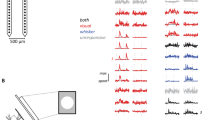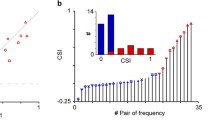Abstract
Neurons in the superior colliculus (SC) are known to integrate stimuli of different modalities (e.g., visual and auditory) following specific properties. In this work, we present a mathematical model of the integrative response of SC neurons, in order to suggest a possible physiological mechanism underlying multisensory integration in SC. The model includes three distinct neural areas: two unimodal areas (auditory and visual) are devoted to a topological representation of external stimuli, and communicate via synaptic connections with a third downstream area (in the SC) responsible for multisensory integration. The present simulations show that the model, with a single set of parameters, can mimic various responses to different combinations of external stimuli including the inverse effectiveness, both in terms of multisensory enhancement and contrast, the existence of within- and cross-modality suppression between spatially disparate stimuli, a reduction of network settling time in response to cross-modal stimuli compared with individual stimuli. The model suggests that non-linearities in neural responses and synaptic (excitatory and inhibitory) connections can explain several aspects of multisensory integration.











Similar content being viewed by others
References
Amlot, R., Walken, R., Driver, J., & Spence, C. (2003). Multimodal visual–somatosensory integration in saccade generation. Neuropsychology, 41, 1–15.
Anastasio, T. J., & Patton, P. E. (2003). A two-stage unsupervised learning algorithm reproduces multisensory enhancement in a neural network model of the corticotectal system. Journal of Neuroscience, 23, 6713–6727.
Anastasio, T. J., Patton, P. E., & Belkacem-Boussaid, K. (2000). Using Bayes rule to model multisensory enhancement in the superior colliculus. Neural Computation, 12, 1165–1187.
Bell, A. H., Corneil, B. D., Meredith, M. A., & Munoz, D. P. (2001). The influence of stimulus properties on multisensory processing in the awake primate superior colliculus. Canadian Journal of Experimental Psychology, 55, 123–132.
Ben-Yishai, R., Bar, O., & Sompolinsky, H. (1995). Theory of orientation tuning in visual cortex. Proceedings of the National Academy of Sciences of the United States of America, 92, 3844–3848.
Bermant, R. I., & Welch, R. B. (1976). Effect of degree of separation of visual–auditory stimulus and eye position upon spatial interaction of vision and audition. Perceptual and Motor Skills, 43, 487–493.
Edwards, S. B., Ginsburgh, C. L., Henkel, C. K., & Stein, B. E. (1979). Sources of subcortical projections to the superior colliculus in the Cat. Journal of Comparative Neurology, 184, 309–330.
Frassinetti, F., Bolognini, N., & Ladavas, E. (2002). Enhancement of visual perception by crossmodal visuo-auditory interaction. Experimental Brain Research, 147, 332–343.
Frens, M. A., & Van Opstal, A. J. (1998). Visual-auditory interactions modulate saccade-related activity in monkey superior colliculus. Brain Research Bulletin, 46, 211–224.
Frens, M. A., Van Opstal, A. J., & Van der Willigen, R. F. (1995). Spatial and temporal factors determine auditory–visual interactions in human saccadic eye movements. Perception & Psychophysics, 57, 802–816.
Huerta, M. F., & Harting, J. K. (1984). The mammalian superior colliculus: studies of its morphology and connections. In H. Vanegas (Ed.), Comparative neurology of the optic tectum (pp. 687–773). New York: Plenum.
Hughes, H. C., Reuter-Lorenz, P. A., Nozawa, G., & Fendrich, R. (1994). Visual–auditory interactions in sensorimotor processing: saccades versus manual responses. Journal of Experimental Psychology. Human Perception and Performance, 20, 131–153.
Jiang, W., Jiang, H., & Stein, B. E. (2002). Two corticotectal areas facilitate multisensory orientation behavior. Journal of Cognitive Neuroscience, 14, 1240–1255.
Jiang, W., & Stein, B. E. (2003). Cortex controls multisensory depression in superior colliculus. Journal of Neurophysiology, 90, 2123–2135.
Jiang, W., Wallace, M. T., Jiang, H., Vaughan, J. W., & Stein, B. E. (2001). Two cortical areas mediate multisensory integration in superior colliculus neurons. Journal of Neurophysiology, 85, 506–522.
Kadunce, D. C., Vaughan, J. W., Wallace, M. T., Benedek, G., & Stein, B. E. (1997). Mechanisms of within- and cross-modality suppression in the superior colliculus. Journal of Neurophysiology, 78, 2834–2847.
Kadunce, D. C., Vaughan, J. W., Wallace, M. T., & Stein, B. E. (2001). The influence of visual and auditory receptive field organization on multisensory integration in the superior colliculus. Experimental Brain Research, 139, 303–310.
King, A. J., & Palmer, A. R. (1985). Integration of visual and auditory information in bimodal neurons in the Guinea pig superior colliculus. Experimental Brain Research, 60, 492–500.
Meredith, M. A., & Stein, B. E. (1986a). Spatial factors determine the activity of multisensory neurons in cat superior colliculus. Brain Research, 365, 350–354.
Meredith, M. A., & Stein, B. E. (1986b). Visual, auditory, and somatosensory convergence on cells in superior colliculus results in multisensory integration. Journal of Neurophysiology, 56, 640–662.
Meredith, M. A., & Stein, B. E. (1996). Spatial determinants of multisensory integration in cat superior colliculus neurons. Journal of Neurophysiology, 75, 1843–1857.
Mize, R. R., Withworth, H., Nunes-Cardozo, B., & van der Want, J. (1994). Ultrastructural organization of GABA in the rabbit superior colliculus revealed by quantitative postembedding immunocytochemistry. Journal of Comparative Neurology, 341, 273–287.
Patton, P. E., & Anastasio, T. J. (2003). Modelling cross-modal enhancement and modality-specific suppression in multisensory neurons. Neural Computation, 15, 783–810.
Patton, P. E., Belkacem-Boussaid, K., & Anastasio, T. J. (2002). Multimodality in the superior colliculus: an information theoretic analysis. Brain Research, Cognitive Brain Research, 14, 10–19.
Peck, C. K. (1996). Visual–auditory integration in cat superior colliculus: Implications for neuronal control of the orienting response. Progress in Brain Research, 112, 167–177.
Perrault Jr., T. J., Vaughan, J. W., Stein, B. E., & Wallace, M. T. (2003). Neuron-specific response characteristics predict the magnitude of multisensory integration. Journal of Neurophysiology, 90, 4022–4026.
Perrault Jr., T. J., Vaughan, J. W., Stein, B. E., & Wallace, M. T. (2005). Superior colliculus neurons use distinct operational modes in the integration of multisensory stimuli. Journal of Neurophysiology, 93, 2575–2586.
Perrott, D. R., Saberi, K., Brown, K., & Strybel, T. Z. (1990). Auditory psychomotor coordination and visual search performance. Perception & Psychophysics, 48, 214–226.
Populin, L. C. (2005). Anesthetics change the excitation/inhibition balance that governs sensory processing in the cat superior colliculus. Journal of Neuroscience, 25, 5903–5914.
Populin, L. C., & Yin, T. C. T. (2002). Bimodal interactions in the superior colliculus of the behaving cat. Journal of Neuroscience, 22, 2826–2834.
Schroger, E., & Widmann, A. (1998). Speeded responses to audiovisual signal changes result from bimodal integration. Psychophysiology, 35, 755–759.
Sparks, D. L. (1986). Translation of sensory signals into commands for control of saccadic eye movements: Role of primate superior colliculus. Physiological Reviews, 66, 118–171.
Stanford, T. R., Quessy, S., & Stein, B. E. (2005). Evaluating the operations underlying multisensory integration in the cat superior colliculus. Journal of Neuroscience, 25, 6499–6508.
Stein, B. E. (1998). Neural mechanisms for synthesizing sensory information and producing adaptive behaviors. Experimental Brain Research, 123, 124–135.
Stein, B. E., Huneycutt, W. S., & Meredith, M. A. (1988). Neurons and behavior: The same rules of multisensory integration apply. Brain Research, 448, 355–358.
Stein, B. E., & Meredith, M. A. (1993). The merging of the senses. Cambridge, MA: MIT.
Stein, B. E., Meredith, M. A., Huneycutt, W. S., & McDade, L. (1989). Behavioral indices of multisensory integration: Orientation to visual cues is affected by auditory stimuli. Journal of Cognitive Neuroscience, 1, 12–24.
Treves, A. (1993). Mean-field analysis of neuronal spike dynamics. Network, 4, 259–284.
Wallace, M. T., Meredith, M. A., & Stein, B. E. (1993). Converging influences from visual, auditory, and somatosensory cortices onto output neurons of the superior colliculus. Journal of Neurophysiology, 69, 1797–1809.
Wallace, M. T., Meredith, M. A., & Stein, B. E. (1998). Multisensory integration in the superior colliculus of the alert cat. Journal of Neurophysiology, 80, 1006–1010.
Wallace, M. T., Wilkinson, L. K., & Stein, B. E. (1996). Representation and integration of multiple sensory inputs in primate superior colliculus. Journal of Neurophysiology, 96, 1246–1266.
Welch, R. B., & Warren, D. H. (1986). Intersensory interaction. In K. R. Boff, L. Kaufman, & J. P. Thomas (Eds.), Handbook of perception and human performance (pp. 1–36). New York: Wiley.
Wilkinson, L. K., Meredith, M. A., & Stein, B. E. (1996). The role of anterior ectosylvian cortex in cross-modality orientation and approach behavior. Experimental Brain Research, 112, 1–10.
Author information
Authors and Affiliations
Corresponding author
Additional information
Action Editor: Alessandro Treves
Rights and permissions
About this article
Cite this article
Ursino, M., Cuppini, C., Magosso, E. et al. Multisensory integration in the superior colliculus: a neural network model. J Comput Neurosci 26, 55–73 (2009). https://doi.org/10.1007/s10827-008-0096-4
Received:
Revised:
Accepted:
Published:
Issue Date:
DOI: https://doi.org/10.1007/s10827-008-0096-4




